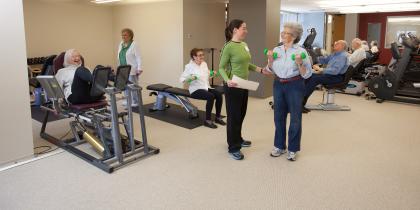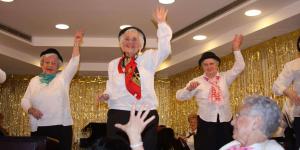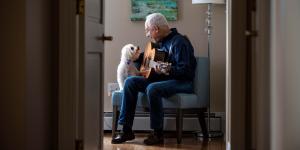Exercise Plan Tips for Seniors

Staying active—think moving more and sitting less—is important for everyone, particularly seniors. Maintaining physical health is a key aspect to maintaining independence - strong muscles, solid balance, and stamina will help you bring groceries into the house, play with your grandchildren, and allow you to be more resilient should you fall or have an illness.
Physical activity has immediate health benefits including better sleep and less anxiety. It can also help you feel better, improve your balance, and boost your brain health. Additional health benefits include a reduced risk of chronic conditions such as heart disease, Type 2 diabetes, and depression.
Beyond the physical and mental health benefits of exercise, if you exercise outside your home it’s a good opportunity to meet friends, provide social stimulation, and avoid isolation.
Sarah Charest is the rehab manager of the Hebrew Rehabilitation Center in Boston and at NewBridge on the Charles in Dedham, where she manages the Get Up and Go exercise program. Accordingly, she has some valuable advice for older adults who are looking to begin an exercise program.
How much exercise should older adults be getting?
According to the CDC, adults aged 65 and older need at least 150 minutes a week of moderate-intensity activity such as brisk walking, or 75 minutes a week of vigorous-intensity activity such as hiking, jogging, or running. Additionally, it is recommended that seniors practice activities that strengthen muscles at least two days a week, and activities to improve balance—such as standing on one foot—about three days a week.
150 minutes a week sounds like a lot but that’s only 30 minutes per day for five days a week. Also, keep in mind that this number is a cumulative total and it certainly doesn’t need to be done all at once. A 15-minute walk in the morning and afternoon with a tai chi session a few days a week can get you all the exercise you need.
How do you know if you’re doing moderate or vigorous aerobic activity?
Everyone’s fitness level is different. Rather than focusing on what “should” count as moderate or vigorous, you should evaluate how different activities make you feel. Exercise will increase your heart rate and respiration—the question is to what degree it will affect you.
A rough gauge of intensity would be to evaluate your rate of breathing. Vigorous activity means you are breathing hard and are unable to say more than a few words without stopping to catch your breath. Moderate-intensity activity increases your breathing to the point where you can still have a conversation, but can’t sing.
What are some good exercises for seniors?
Whether you go to a gym or work out at home, variety is an important aspect of a good exercise plan. You should include a combination of strength exercises, balance exercises, and aerobic activity. However, the best exercises are the ones that match your abilities, and that you want to do. This will help ensure that you stick with them.
Keep in mind, some physical activity is better than none. Even cleaning your house can be a good way to supplement your exercise. If you have trouble with daily activities, such as climbing stairs or walking, exercise is still important and might even alleviate some issues. Perhaps you can start with five minutes of walking and practice a few sit-to-stand exercises, and progress from there as your strength and stamina improve.
If you have a health condition such as arthritis, diabetes, or heart disease, regular physical activity can improve your quality of life and even reduce your risk of developing other conditions. Be sure to check in with your health care provider before starting any exercise program.
Strength exercises
Muscle strength is important to maintain your physical health and mobility. These types of activities will help keep you from losing muscle as you get older. Not only can you maintain your existing strength, you can also build muscle as you age. While that may seem obvious today, there was a time when muscle strengthening was viewed as dangerous for older adults. In the 1980s, Hebrew SeniorLife’s Hinda and Arthur Marcus Institute for Aging Research conducted some of the very first research proving that not only was weight training safe for seniors, it was beneficial and helped build muscle for even people in their 90s.
To gain health benefits, you need to do muscle-strengthening activities to the point where it’s hard for you to do another repetition without help. A repetition is one complete movement of an activity, like lifting a weight or doing one sit-up. Try to do eight to 12 repetitions per activity, which counts as one set. Try to do at least one set of muscle-strengthening activities, but to gain even more benefits, do two or three sets.
The activities you choose should work all the major muscle groups of your body (legs, hips, back, chest, abdomen, shoulders, and arms). You may want to try:
- Lifting weights or working with resistance bands
- Doing exercises that use your body weight for resistance (push-ups, sit-ups)
- Heavy gardening (digging, shoveling)
- Some forms of yoga
If you’re exercising at home and don’t have weights, get creative! Soup cans, water bottles, or a backpack with a few books in it can all substitute in a pinch. In fact, a one-liter water bottle weighs 2.2 lbs.
This video from Hebrew SeniorLife’s Orchard Cove continuing care retirement community in Canton, MA shows you three exercises that work on your arms, legs, and core strength. All you need is a chair.
Balance activities
Working on your balance is an important part of preventing falls and improves overall mobility. Strengthening the back, abdomen, and leg muscles also improves balance. Here are some exercises to try:
- Walking backward
- Standing on one leg
- Chair yoga
- Evidenced-based programs like Tai Ji Quan: Moving for Better Balance
When starting with balance exercises, keep a chair, wall, or countertop nearby to steady yourself in case you get wobbly. For more of a challenge, try closing your eyes as you balance on one leg. As you become more comfortable add some dual tasking to your routine. This would include any activities where you need to concentrate on a task while being mobile, like side-stepping while counting backward from 10.
Aerobic activity
Aerobic physical activity or “cardio” gets you breathing harder and your heart beating faster. This kind of exercise helps strengthen the cardiovascular system, improving circulation and lowering blood pressure. It also burns more calories. Here are some examples:
- Walking or hiking
- Some forms of yoga
- Bicycle riding (stationary or outdoors)
- Water aerobics
What should older adults look for in a gym?
Some people enjoy going to a gym and find it gives them extra motivation to be consistent, in addition to the availability of fitness machines you may not have at home. However, finding a gym that is a good fit for an older person's needs can feel overwhelming. Here are some specific aspects to look for:
Make sure the gym provides supervision. Some gyms can be intimidating and older adults may feel like they’re on their own. Make sure the gym has trained staff who are there to assist and support you as you exercise.
- Make sure that the staff providing the supervision are knowledgeable and trained to work with seniors. The staff should understand the conditions of aging and be familiar with techniques that target maximizing function.
- Does the gym have the proper equipment to meet your needs? It doesn’t have to be fancy, it just has to be right for you.
- Does your gym offer the right social environment? Do you see yourself fitting in? It’s important that you enjoy the other offerings at your gym. Check to see what special programs are offered.
- Is there a health concern that worries you? If you have recently been discharged from a hospital, is this gym the right place for you? If you have a physical disability, are the set-up of the gym, the equipment, and other amenities like locker rooms fully accessible?
- Ask about the gym’s cleaning protocols. Do they regularly sanitize equipment and surfaces to prevent the spread of COVID-19, influenza, and other illnesses? Are cleaning supplies (spray bottles, wipes, paper towels) easily available so gym-goers can wipe down equipment after using it, and do you observe that happening regularly as you walk around?
- Call gyms in your area and request information. Visit one or two before enrolling.
- Do your homework before making the decision to join a gym or begin an exercise program, and make sure you are comfortable before signing any contracts. Taking another week or two to find the right fit will pay off since spending time at a gym each week can have life-long health benefits.
Supervised indoor workout options for seniors in Boston
Another great option is to exercise indoors at a program like Get Up & Go, which is a supervised senior fitness program offered at Hebrew Rehabilitation Center in Roslindale. Exercise physiologists who specialize in working with older adults will create an individualized workout program for you that focuses on strength, balance, and endurance. Your workouts will be overseen by our team of professionals who’ll give you ongoing guidance and encouragement – all for less than the cost of a personal trainer or boutique fitness studio. Ready to give it a try? Call us today at 617-363-8284 or contact us online.
Blog Topics
Learn More
Senior Fitness
Our exercise physiologists specialize in fitness for older adults and will develop a personalized exercise program for you.




